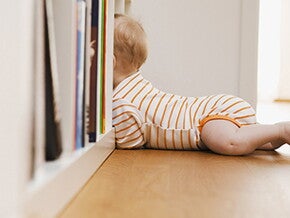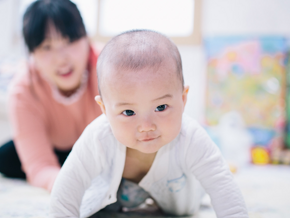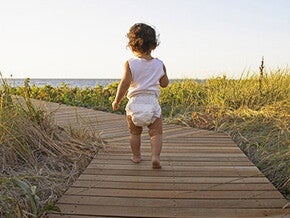
Your 10-12-month-old’s activity planner
At 10-12 months, playing remains an important part of your baby’s development. It’s fun for you both and is a great way of spending time together, creating special memories along the way. Also, it’s recommended that toddlers between the ages of one and two years old are active for at least 60-180 minutes over the course of a day, and shouldn’t be sitting still for more than an hour at a time (apart from when sleeping). So now’s the time to get your little one into the habit of being active!
Even though your baby may now think it’s much more fun to play than sleep, try to keep the morning and afternoon naps going. At this age, your baby is very busy, so he still needs adequate sleep to balance the activity and make sure he’s got plenty of energy.
Encouraging your baby to be active when he’s young helps set up healthy habits that may last a lifetime. Now that your baby is getting more mobile, building up his strength, and becoming capable of more complex movements, why not try out these five activity ideas?

-
What? Push and pull
How? Give your baby a ball or a toy on wheels so he can practice pushing and pulling it along the floor. For babies who are already cruising or walking, push toys, or ‘walkers’ that allow your baby to walk with support, are great.
Why? Pushing toys along the floor will help strengthen your baby’s arm muscles and encourage him to use both hands in a coordinated way. He will also be able to practice either walking, cruising, or crawling to get the toy back when it’s out of reach.

-
What? Shake it all about
How? Sing action songs and rhymes to your baby and perform the moves together. Support your baby by holding his hands so he can move to the words and music. Songs like ‘The hokey pokey’, ‘Head, shoulders, knees, and toes,’ and, ‘Row, row your boat’ are classics.
Why? Moving to music can help develop your baby’s physical coordination, imitation skills, and rhythm.

-
What? Let’s shoot hoops!
How? Your baby doesn’t need to be walking to start developing his budding basketball skills. Put or hold a basket, tub, or box on the floor a short distance way. Place a ball in front of him and encourage him to pick it up and throw it towards the basket.
Why? Ball games are great for eye/hand coordination and developing motor skills. They also teach him that being active is fun and gives a sense of achievement.

-
What? Little scooter
How? While your baby is practicing his crawling on all fours, face him and start to back away, without ever going out of his sight. Keep him reassured by talking to him and encouraging him to crawl towards you.
Why? As your baby will be keen to catch up with you (and get a cuddle!), backing away, and encouraging him to come to you, can help boost his crawling speed and confidence. This helps him build up the muscle strength he’ll need for cruising and learning to walk.

-
What? Walk the walk
How? Hold your baby’s hands, or one hand if he is confident enough, and encourage him to walk around. Make it more fun and challenging by adding obstacles, such as cushions, for him to walk over, and items, such as side tables, for him to walk around.
Why? Your baby may now have the strength to stand alone, cruise around, and maybe even take his first steps. This game will help him practice those skills and give him the confidence to try and take his first steps on his own.
Safety checklist
Your baby loves to be on the move now. In the blink of an eye he has crawled across the room. He may even be pulling himself up to standing and starting to cruise along the furniture. After all that activity make sure your baby stays hydrated by offering him a drink of water during and after playtime. Also be sure to provide safe, supervised play for your baby.
Choose an area of the floor to dedicate to your baby’s play. Make it a safe play space by:
- Removing anything that could hurt your baby
- Checking for, and removing, any choking hazards
- Locking cabinets and doors
- Covering electrical outlets
- Installing safety gates
- Keeping any walkers or push-and-pull toys away from stairs and steps
Sources
Shelov SP & Altmann TR (Eds.). (2009). American Academy of Pediatrics. The complete and authoritative guide Caring for your baby and young child birth to age 5 (5th ed.). USA: Bantam Books.
https://pathways.org/growth-development/baby/milestones/ (Accessed April 11 2018)
https://pathways.org/growth-development/baby/games/ (Accessed April 11 2018)


















